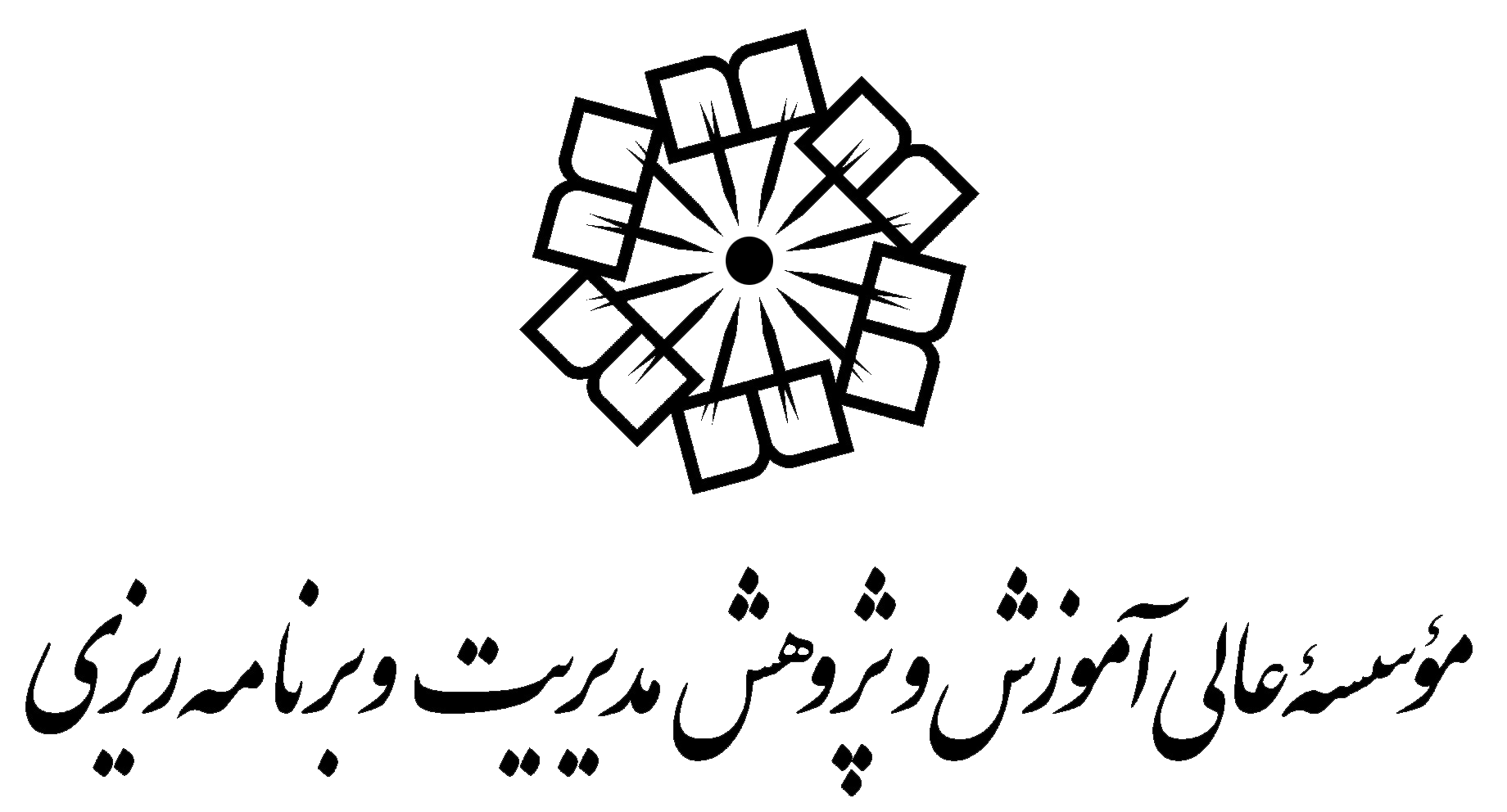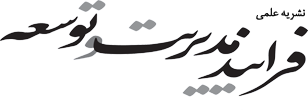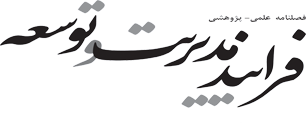دوره 37، شماره 3 - ( پاییز 1403 )
دوره37 شماره 3 صفحات 118-81 |
برگشت به فهرست نسخه ها
Download citation:
BibTeX | RIS | EndNote | Medlars | ProCite | Reference Manager | RefWorks
Send citation to:



BibTeX | RIS | EndNote | Medlars | ProCite | Reference Manager | RefWorks
Send citation to:
Hosseinzadeh Arablouiyekan R, Rahnavard F, Alinezhad A. (2024). Explaining the Dimensions and Components of Ambi/ tridexterity Universities in Iran. JMDP. 37(3), 81-118.
URL: http://jmdp.ir/article-1-4762-fa.html
URL: http://jmdp.ir/article-1-4762-fa.html
حسین زاده عربلوی یکان رسول، رهنورد فرج اله، علی نژاد علیرضا. تبیین ابعاد و مولفه های دانشگاههای دو(سه)سوتوان در ایران فرایند مدیریت و توسعه 1403; 37 (3) :118-81
1- گروه مدیریت دولتی، واحد قزوین، دانشگاه آزاد اسلامی، قزوین، ایران.
2- گروه مدیریت، موسسه عالی آموزش و پژوهش مدیریت و برنامهریزی، تهران، ایران. ،frahnavard@imps.ac.ir
3- گروه مهندسی صنایع، واحد قزوین، دانشگاه آزاد اسلامی، قزوین، ایران.
2- گروه مدیریت، موسسه عالی آموزش و پژوهش مدیریت و برنامهریزی، تهران، ایران. ،
3- گروه مهندسی صنایع، واحد قزوین، دانشگاه آزاد اسلامی، قزوین، ایران.
چکیده: (947 مشاهده)
هدف: پژوهش حاضر با هدف تعیین ابعاد و مؤلفههای دانشگاههای دو(سه)سوتوان در ایران انجام پذیرفت.
طرح پژوهش/ روششناسی/ رویکرد: پژوهش حاضر بر مبنای اَبَرانگاره تفسیرگرایی، از نظر هدف کاربردی توسعهای، برحسب ماهیت روش از نوع توصیفی و برحسب نوع داده کیفی است. جامعۀ آماری کارشناسان خبرۀ سازمانی و اعضای هیئت علمی دانشگاههاست که نمونۀ آماری به تعداد 27 نفر از بین آنها باتوجهبه ویژگیها و شرایط مورد نیاز برای اعضای پانل دلفی و به روش ترکیبی یعنی دو روش هدفمند و در دسترس تعیین گردید. جهت جمعآوری دادهها از ابزار پرسشنامه بسته و باز پاسخ و مصاحبۀ نیمهساختاریافته استفاده شد. تجزیهوتحلیل دادهها مبتنی بر دو رویکرد دلفی فازی و تحلیل مضمون انجام گرفت.
یافتهها: بر اساس تحلیلهای متن مصاحبهها، ابعاد دانشگاه دو(سه)سوتوان شامل بُعد بهرهبرداری با هفت مؤلفۀ هوش سازمانی، توانمندسازی، سرمایۀ اجتماعی، مدیریت استعداد، ارتباطات، شایستهسالاری و فرهنگ سازمانی؛ بُعد اکتشاف با پنج مؤلفۀ انعطافپذیری منابع انسانی، رهبری فرصتآفرین، خلاقیت و نوآوری، آموزش و توسعه و هدفگذاری راهبردی و بُعد پایداری با چهار مؤلفۀ رشد پایدار منطقهای، تعهد به پایداری، اقدامات زیستمحیطی و تبیین معیارهای پایداری استخراج شده است.
ارزش/ اصالت پژوهش: یافتهها نشان میدهد اگرچه پژوهشهای فراوانی در زمینۀ دوسوتوانی انجام شده است؛ اما اغلب پژوهشهای انجامشده از بُعد تعادل یا ترکیب ابعاد بهرهبرداری و اکتشاف به مفهوم سازمان دوسوتوان نگاه کردهاند، این در حالی است که در پژوهش حاضر علاوه بر اینکه مفهوم دانشگاه دوسوتوان مورد توجه قرار گرفته، بُعد سوم یعنی «پایداری» به عنوان نوآوری در مفهوم دانشگاه دوسوتوان شناسایی شده و مفهوم آن به دانشگاه سهسوتوان ارتقاء یافته است.
طرح پژوهش/ روششناسی/ رویکرد: پژوهش حاضر بر مبنای اَبَرانگاره تفسیرگرایی، از نظر هدف کاربردی توسعهای، برحسب ماهیت روش از نوع توصیفی و برحسب نوع داده کیفی است. جامعۀ آماری کارشناسان خبرۀ سازمانی و اعضای هیئت علمی دانشگاههاست که نمونۀ آماری به تعداد 27 نفر از بین آنها باتوجهبه ویژگیها و شرایط مورد نیاز برای اعضای پانل دلفی و به روش ترکیبی یعنی دو روش هدفمند و در دسترس تعیین گردید. جهت جمعآوری دادهها از ابزار پرسشنامه بسته و باز پاسخ و مصاحبۀ نیمهساختاریافته استفاده شد. تجزیهوتحلیل دادهها مبتنی بر دو رویکرد دلفی فازی و تحلیل مضمون انجام گرفت.
یافتهها: بر اساس تحلیلهای متن مصاحبهها، ابعاد دانشگاه دو(سه)سوتوان شامل بُعد بهرهبرداری با هفت مؤلفۀ هوش سازمانی، توانمندسازی، سرمایۀ اجتماعی، مدیریت استعداد، ارتباطات، شایستهسالاری و فرهنگ سازمانی؛ بُعد اکتشاف با پنج مؤلفۀ انعطافپذیری منابع انسانی، رهبری فرصتآفرین، خلاقیت و نوآوری، آموزش و توسعه و هدفگذاری راهبردی و بُعد پایداری با چهار مؤلفۀ رشد پایدار منطقهای، تعهد به پایداری، اقدامات زیستمحیطی و تبیین معیارهای پایداری استخراج شده است.
ارزش/ اصالت پژوهش: یافتهها نشان میدهد اگرچه پژوهشهای فراوانی در زمینۀ دوسوتوانی انجام شده است؛ اما اغلب پژوهشهای انجامشده از بُعد تعادل یا ترکیب ابعاد بهرهبرداری و اکتشاف به مفهوم سازمان دوسوتوان نگاه کردهاند، این در حالی است که در پژوهش حاضر علاوه بر اینکه مفهوم دانشگاه دوسوتوان مورد توجه قرار گرفته، بُعد سوم یعنی «پایداری» به عنوان نوآوری در مفهوم دانشگاه دوسوتوان شناسایی شده و مفهوم آن به دانشگاه سهسوتوان ارتقاء یافته است.
نوع مطالعه: پژوهشي |
موضوع مقاله:
فرایند توسعه
دریافت: 1403/5/2 | پذیرش: 1403/9/4 | انتشار الکترونیک: 1404/4/31
دریافت: 1403/5/2 | پذیرش: 1403/9/4 | انتشار الکترونیک: 1404/4/31
فهرست منابع
1. Al-Ani, M. K., Al-Lawati, H. M., & Al-Amri, M. m. (2023), Disclosure of organizational ambidexterity activities and earnings quality in Oman, International Journal of Professional Business Review, 8(5), 1-25. [DOI:10.26668/businessreview/2023.v8i5.1393]
2. Alikhani, A. A. (2010), Methods of transformation and improvement of higher education and research in Iran. Journal of Iranian Higher Education, 3(2-1), 1-31. (In Persian)
3. Allami, F., Iranzadeh, S., Khadivi, A., & BudaghiKhajeh Nobar, H. (2021). Investigating the factors affecting ambidexterity in higher education and driving-dependence power analysis using interpretive-structural modeling, Jundishapur Education Development Journal, 12(1), 144-158. (In Persian)
4. Azar, A., Zabihi Jamkhaneh, M., & Mollaei, M. (2020). Investigating the impact of organizational agility on increasing organizational ambidexterity skills, Quarterly Journal of Development & Evolution Management, 42, 11-18. (In Persian)
5. Bluhm, D. J., Harman, W., Lee, T. W., & Mitchell, T. R. (2011). Qualitative research in management: A decade of progress. Journal of Management Studies, 48(8), 1866-1891. [DOI:10.1111/j.1467-6486.2010.00972.x]
6. Braun, V. & Clarke, V. (2006). Using thematic analysis in psychology. Qualitative Research in Psychology, 3, 77-101. [DOI:10.1191/1478088706qp063oa] [DOI:10.1191/1478088706qp063oa]
7. Cao, Q., Gedajlovic, E., & Zhang, H. (2009). Unpacking Organizational Ambidexterity: Dimensions, Contingencies, and Synergistic Effects. Organization Science, 20(4), 781-796. [DOI:10.1287/orsc.1090.0426]
8. Cao, R., & Jiang, R. (2022). Resolving strategic dilemmas in ambidextrous organizations: An integrated second-order factor model perspective, Frontiers in Psychology, 13, PP; 1-17. [DOI:10.3389/fpsyg.2022.797645] [PMID] []
9. Centobelli, P., Cerchione, R., & Esposito, E. (2019). Exploration and Exploitation in the Development of more Entrepreneurial Universities: A twisting Learning Path Model of Ambidexterity. Technological Forecasting and Social Change, 141, 172-194. [DOI:10.1016/j.techfore.2018.10.014]
10. Chang, Y. C., Yang, P. Y. & Chi, H. R. (2016). Entrepreneurial Universities and Research Ambidexterity: A Multilevel Analysis, Technology Innovation, 54, 2-7. [DOI:10.1016/j.technovation.2016.02.006]
11. Clauss, T., Kraus, S., Kallinger, F. L., Bican, P. M., Brem, A., & Kailer, N. (2021), Organizational ambidexterity and competitive advantage: The role of strategic agility in the exploration-exploitation paradox, Journal of Innovation & Knowledge, 6, PP: 203-213. [DOI:10.1016/j.jik.2020.07.003]
12. Duncan, R. B. (1976). The ambidextrous organization: Designing dual structures for innovation. In R. H. Kilmann, L. R. Pondy and D. Slevin (eds.). The management of organization design: Strategies and implementation. NewYork: North Holland, PP: 167-188.
13. Dzenopoljac, A., Dzenopoljac, V., Muhammed, S., Abidi, O., & Kraus, S. (2024), Intra-organizational knowledge sharing, ambidexterity and firm performance: Evaluating the role of knowledge quality, Journal of Knowledge Management, 28(11), 155-179. [DOI:10.1108/JKM-06-2023-0533]
14. Etzkowitz, H. (2016). The Entrepreneurial University: Vision and Metrics, Industry and Higher Education, 30(2), 83-97. [DOI:10.5367/ihe.2016.0303]
15. Forte, S. H. A. C., Silva, M. F. R., & Neto, M. N. F. (2024). Determining factors of organizational ambidexterity in academic performance in private higher education institutions. Revista de Administração Mackenzie, 25(4), 1-30. [DOI:10.1590/1678-6971/eramc240195]
16. Fourné, S. P., Rosenbusch, N., Heyden, M. L., & Jansen, J. J. (2019), Structural and contextual approaches to ambidexterity: A meta-analysis of organizational and environmental contingencies, European Management Journal, 37, PP: 564-576. [DOI:10.1016/j.emj.2019.04.002]
17. Garcia‑Hurtado, D., Devece, C., Hoffmann, V. E., & Crisanto‑Pantoja, M. (2024). On entrepreneurial and ambidextrous universities. Comparative study in Ibero-American Higher Education Institutions, Sustainable Technology and Entrepreneurship, 3, PP: 1-9. [DOI:10.1016/j.stae.2024.100077]
18. Garcia‑Hurtado, D., Devece, C., Zegarra‑Saldana, P. E., & Crisanto‑Pantoja, M. (2022). Ambidexterity in Entrepreneurial Universities and Performance Measurement Systems: A Literature Review, International Entrepreneurship and Management Journal, 5(2), 1-22. [DOI:10.1007/s11365-022-00795-5]
19. Gholipour, M., & Kahani Moghadam, H. (2016). The importance and necessity of paying attention to the third generation university. Collection of selected works and articles from the 10th Congress of Pioneers of Progress, Tehran: Center for the Iranian-Islamic Pattern of Progress. 1, 1510-1516. (In Persian)
20. Gibson, C. B., & Birkinshaw, J. (2004). The antecedents, consequences, and mediating role of organizational ambidexterity, Academy of Management Journal, 47, PP: 209-226. [DOI:10.2307/20159573]
21. Guba, E. G., & Lincoln, Y. S. (1985). Naturalis tic Inquiry: Sage Publications. CA: Sage. [DOI:10.1016/0147-1767(85)90062-8]
22. Guerreo, M., Gunningham, J., & Urbano, D. (2015). Economic Impact of Entrepreneurial Universities' Activities: An Exploratory Study of the United Kingdom. Research Policy, 44, 748-764. [DOI:10.1016/j.respol.2014.10.008]
23. Ho, G. T. S., Lau, H. C. W., Lee, C. K. M., & Ip, A. W. H. (2005). An Intelligent forward Quality Enhancement System to Achieve Product Customization, Industrial Management & Data Systems, 105(3), 384-406. [DOI:10.1108/02635570510590174]
24. Larran-Jorge, M., & Andrades-Pena, F. J. (2017). Analysing the Literature on University Social Responsibility: A Review of Selected Higher Education Journals, Higher Education Quarterly, 71, 302-319. [DOI:10.1111/hequ.12122]
25. Lis, A., Józefowicz, B., Tomanek, M., & Gulak-Lipka, P. (2018). The concept of the ambidextrous organization: Systematic literature review, International Journal of Contemporary Management, 17(1), PP: 77-97. [DOI:10.4467/24498939IJCM.18.005.8384]
26. March, J. G. (1991), Exploration and exploitation in organizational learning, Organization Science, 2(1), PP: 71-87. [DOI:10.1287/orsc.2.1.71]
27. Moradi, M., Ebrahimpour, M., & Mombini, Y. (2014). Ambidextrous organizations, competitive and entrepreneurial organizations, The Second National Conference on Entrepreneurship and Competitiveness, Mazandaran: University of Mazandaran. (In Persian)
28. Moradi, M., Keikhosro, Y., & Madani, F. (2015). Ambidextrous organizational culture and performance: The critical role of organizational ambidexterity, Organizational Culture Management, 13(4), 1245-1266. (In Persian)
29. Nasereddin, A., & Rababa, F. A. (2020). The Role of Strategic Entrepreneurship on Organizational Ambidexterity: A Case Study of Middle East University-Jordan, International Journal of Management, 11(12), 2558-2574. [DOI:10.34218/IJM.11.12.2020.240]
30. O'Reilly, C. A., & Tushman, M. L. (2013). Organizational Ambidexterity: Past, Peresent, & Future. The Academy of Management Perspectives, 27(4), 324-338. [DOI:10.5465/amp.2013.0025]
31. Ochie, C., Nyuur, R. B., Ludwig, G., Cunningham, J. A. (2022). Dynamic Capabilities and Organizational Ambidexterity: New Strategies from Emerging Market Multinational Enterprises in Nigeria, Thunderbird International Business Review published by Wiley Periodicals LLC, 1, 1-17. [DOI:10.1002/tie.22266]
32. Oliveira, D., Valentina, D., & Possamai, O. (2012). Forecasting Project Performance Considering the Influence of Leadership Style on Organizational Agility, International Journal of Productivity & Performance Management, 61(6), 653-671. [DOI:10.1108/17410401211249201]
33. Pellegrinelli, S., Murray-Webster, R., & Turner, N. (2015), Facilitating organizational ambidexterity through the complementary use of projects and programs, International Journal of Project Management, 33(1), PP: 153-164. [DOI:10.1016/j.ijproman.2014.04.008]
34. Peterka, S. O., & Salihovic, V. (2012). What is Entrepreneurial University and Why We Need it?, Economy of Eastern Croatia Yesterday, Today, Tomorrow, 1(3), 98-107.
35. Pourabedy, M. R., Moghimi, S. M., Gholipour, A., & Azar, A. (2015). Design and explanation of ambidexterity model in scientific & technological organizations (Evidence in ACECR), thesis of PhD, University of Tehran, Faculty of management. (In Persian)
36. Rashidi, Z. (2018). Analyzing the status of educational quality in Iranian universities and providing solutions for its improvement, Institute for Higher Education Research and Planning, Collection of Specialized Reports on Higher Education, 6, 1-91. (In Persian)
37. Sartori, P. P., & Garrido, I, L. (2023), Organizational ambidexterity and innovation: Propositions for the advancement of theory and practice, Brazilian Business Review, 4, 215-234. [DOI:10.15728/bbr.2023.20.2.6.en]
38. Simsek, Z. (2009), Organizational ambidexterity: towards a multilevel understanding, Journal of Management Studie, 46(4), PP: 597-624. [DOI:10.1111/j.1467-6486.2009.00828.x]
39. Sliż, P., & Dobrowolska, E. (2023). The ambidextrous university concept: balancing exploitation and exploration in higher education. Scientific Papers of Silesian University of Technology Organization and Management Series, 177, 1-22. [DOI:10.29119/1641-3466.2023.177.34] [DOI: 10.29119/1641-3466.2023.177.34]
40. Soares, J. L., Reis, D. R. D. (2021). Organizational Ambidexterity in Higher Education Institutions: Proposition of Evolutive Stages of Ambidexterity, Rev. Adm. UFSM, Santa Maria, 14(1), 100-118. [DOI:10.1504/IJMIE.2020.108005]
41. Soares, J. L., Reis, D. R. D., Cunha, J. C. D., & Neto, P. J. S. (2018). Organizational Ambidexterity: A Study in Brazilian Higher Education Institutions, Journal of technology management & innovation, 13(3), 1-19. [DOI:10.4067/S0718-27242018000300036]
42. Teece, D. J., Peteraf, M. A., & Leih, S. (2016). Dynamic Capabilities and Organizational Agility: Risk, Uncertainty and Strategy in the Innovation Economy. California Management Revie, 58(4), 13-35. [DOI:10.1525/cmr.2016.58.4.13]
43. Tushman, M. L., & O'Reilly, C. A. (1996). Ambidextrous organizations: Managing evolutionary and revolutionary change, California Management Review, 38(4), PP: 8-30. [DOI:10.2307/41165852]
44. Vahedi, M., Panahian, H., Ghodrati, H., & Rasolian, M. (2022). Presenting a model for organizational ambidexterity in Tejarat Bank of Isfahan using combined methods of grounded theory and fuzzy Delphi. Journal of Productivity Management. 16(3), 151-187. (In Persian)
45. Vakili, Y., Nazari, K., Khastar, H., & Shahriari, S. (2020). A model of ambidextrous organization for banking industry. Journal of Innovation Management in Defensive Organizations, 3(10), 29-50. [DOI:10.22034/qjimbo.2020.236695.1329]
46. Venkataraman, S. (2004). Regional Transformation through Technological Entrepreneurship. Journal of Business Venturing, 19, 153-167. [DOI:10.1016/j.jbusvent.2003.04.001]
47. Windle, P. E. (2004). Delphi technique: assessing component needs, Journal of Perianesth Nurs, 19(1), 46-47. [DOI:10.1016/j.jopan.2003.11.005] [PMID] [DOI: 10.1016/j.jopan.2003.11.005]
48. Yaghubi, A., Delgoshaei, Y., HosseiniTabaghdehi, l., & Kordestani, F. (2021). The role of organizational ambidexterity in commercializing knowledge to provide a model. Business Management Quarterly. 50, 597-622. (In Persian)
49. Yu, X., Chen, Y., Nguyen, B., & Zhang, W. (2014). Ties with Government, Strategic Capability, & Organizational Ambidexterity: Evidence from China's Information Communication Technology Industry, Information Technology & Management, 15(2), 81-98. [DOI:10.1007/s10799-014-0175-3]
50. Yuan, X., Hao, H., Guan, C., & Pentland, A. (2022). Which Factors affect the Performance of Technology Business Incubators in China? An Entrepreneurial Ecosystem Perspective. Plos One, 17(1), e0261922. [DOI:10.1371/journal.pone.0261922] [PMID] []
51. Yunita, T., Sanmoko, S., Bandur, A., & Alamslah, F. (2023), Organizational ambidexterity: The role of technological capacity and dynamic capabilities in the face of environmental dynamism, Heliyon, 9, 1-12. [DOI:10.1016/j.heliyon.2023.e14817] [PMID] []
| بازنشر اطلاعات | |
 |
این مقاله تحت شرایط Creative Commons Attribution 4.0 International License قابل بازنشر است. |






